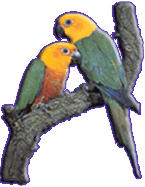|
|
| |
|
|
|
|
FICHER'S LOVEBIRD
Agapornis Fischeri |
|
|
|
First notes on Ficher's lovebird were made by ornithologist Reichow in 1887.
They too, like all parrot of genus “Agapornis”, come from Africa . They mostly inhabit north Tanzania , Victoria lake, Kenia, and they can be seen in smaller flocks in south Ruanda i Burundiji, but only at 1100 to 2000m altitude. They nestle in bushy trees, some palm trees and acacia trees. Some flocks make nests in holes dug in rocks where they make corridors and eaves. There are between 20 and 80 birds in one flock, when not mating. In that period they are very noisy. They geather at cultivated areas, especially cornfields, sunflower fields, and fields with millet and oats, because that is their main food. This parrots like their food served on the ground, and when having a meal on those fields one can see several hundred of these amazing birds. They are not bashful, as a matter a fact they are very friendly. They migrate often because of the food, and in mating period they form nomadic groups with characteristic fast and straight line flights. In this situations Ficher's lovebirds make their natural calls very similar to whistles, which isn't characteristic to their relatives peach-faced lovebirds.
|
|
|
Population of ficher's lovebirds isn't endangered, but it has been reduced in the last few years because of frequent hunts and exports. It is estimated that in the wild there are about 100000 birds. This is a clear sign for people to stop hunting this birds, so that in the future we wouldn't have to worry about this specious survival. |
|
ficher's lovebird (in front of the right),
olive colored ficher's lovebird and peach-headed lovebird at the left part of the photo |
ficher's lovebird (left) and peach-faced lovebird (right)
|
| Ficher's lovebirds, as the same as their relatives, grow up to 15cm and belong to short tailed group. The main color is green, cheeks, throat and crop are yellowish-orange, nape and pate are rust colored. Brest is yellowish-orange, abdominal part and belly are greenish-yellow. Rump is bright blue, and wins and tail are greenish blue. The most impressive parts are powerful red beak and grey legs. Difference between male and female is visually impossible. They are both the same when it comes to color or body shape. The only difference is that females have pelvic slightly apart from thorax than males. This can be found only by expert ornithologist or breeder, but even they can often get wrong.
|
|
|
|
In wild the mating period is in dry period of january and february, through april, june and even july. The couples separate from the flock and start building the nest in the holes of trees or in tunnels of rocks. The nest is made from small parts of bark in spherical shape and labirint type with two entrances. The hen hatches 3 to 6 white eggs sized 23x17mm, and broods for the next 20 days. After the chicks hatch out, they stay in the nets for 5 more weeks.
|
|
|
Two ficher's lovebirds in front,
behind them, several blue masked lovebirds and one ficher's lovebird
and one green (normal) peach-headed lovebird. |
|
|
Their diet consists of millet, oats, sunflower, corn, sorghum, hemp and bright seeds with the addition of fruits and vegetables. They are great water fans, so they must have baths. As pets always keep them in pair, yet they are love birds. Only if they are in pair you can see their true nature, their caring and loving personalities. Their song is medium high, very different from peach-headed lovebirds, but still vary nice to hear.
|
|
| ficher's lovebird
|
|
|
There is considerable number of mutations obtained by genetic crossbreeding, so even in our country one can find yellow, blue, olive, silver or even white (albino) Ficher. Crossbreeding of certain mutations resulted in other variations of color, and whatever the color may be, this bird is lively and pleasant pet. They don't need a big cage, and they can live up to 30 years, so if Ficher is your choice you'll be having a chance to spend your free time in a pleasant company of this little, feathery, beauty.
|
|
|
| |
|
|
|
|
|
| |
|
|
|
|

